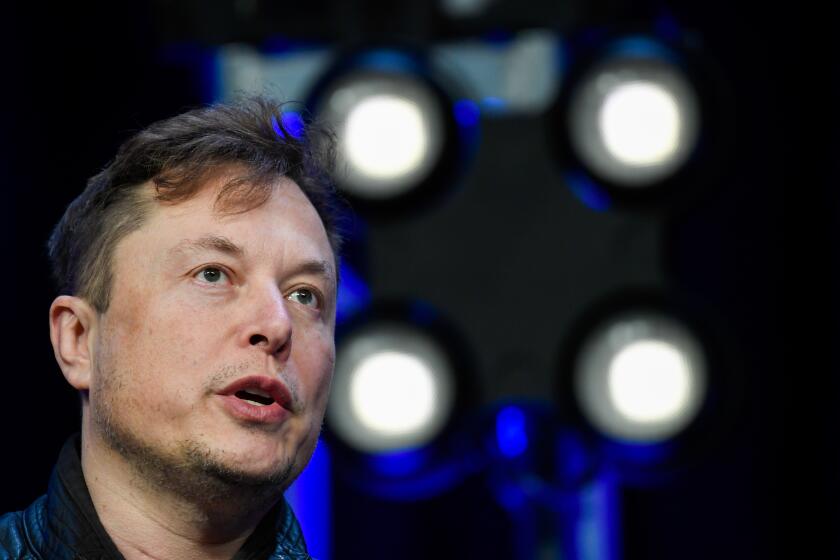Interest Fizzles in All-Electric
The auto industry is pulling the plug on the all-electric car.
The present generation of battery-powered electric vehicles, with their limited driving range of about 120 miles before needing a recharge, have lost favor among automakers and regulators. In turn, the dream of a California highway system buzzing with clean electric cars has been put on indefinite hold.
Just this week at the electric-vehicle trade association’s annual convention in Hollywood, Fla., carmakers instead were touting hybrid gas-electric vehicles, already sold by Toyota Motor Corp. and Honda Motor Co., as the best answer for the environment.
Meanwhile, hydrogen-fuel-cell vehicles -- the next big technology dream -- still are decades away from mass production.
“The focus now is on hybrid electric cars and then fuel cells,” said Mike Schwartz, director of Ford Motor Co.’s Sustainable Mobility Technologies unit. “Hybrids are the interim step that let us use advanced technologies that will be essential for fuel cells when we finally get there.”
Last month, General Motors Corp. began bailing out of its $1-billion experiment with its futuristic two-seat EV-1 electric car, calling it a dismal failure.
Though all 950 of GM’s electric models made from 1996 to 1999 were leased and there still is a waiting list, the company said the program was not economically feasible.
A few weeks ago GM began reclaiming EV-1 vehicles as leases expired, and the last one will be off California roads by August 2004.
For its part, Ford ended its Think electric car project in the summer because it could not find a market for the two- and four-seat autos.
Even the trade group for all-electric cars is shifting gears. On Wednesday, the Electric Vehicle Assn. of the Americas was re-christened the Electric Drive Transportation Assn. The new name better reflects its mission “of advocating all types of electric transportation technology,” said Co-Chairman John Wallace, a former Ford executive who ran the Think car unit.
Like others in the industry, Wallace said the future is in the hydrogen-fuel-cell vehicle.
This technology, now being tested in a few cars in California by Honda and Toyota, relies on a complicated electrochemical process to produce electricity from hydrogen cells on board the vehicle.
But it will take a long time for the auto industry to perfect fuel cells and develop the hydrogen fuel infrastructure needed to make them usable.
“This is a generational pursuit,” Wallace said. “It will be our children who make it happen.”
In the interim, the California Air Resources Board is preparing once again to revise the zero-pollution-emission vehicle mandate that triggered the electric car movement more than a decade ago.
Because of its severe air quality problems, California is the only state allowed to set up emission requirements that are tougher than those of the federal government. California’s pollution rules, in turn, often force automakers to adopt expensive technologies.
But bowing to economic arguments raised by the auto industry, the California air board has repeatedly reduced the scope of its Zero Emission Vehicle Mandate. Years ago, the air board ordered that 4% of all vehicles sold in California must be zero-emission polluters by the 2003 model year.
Later, the board reduced that number to 2% and changed the target date to 2005. Now, the board is considering a proposal from its staff to cut the required sales figure to just 1%.
Automakers already get credit for a variety of advanced-technology and ultra-low-emission vehicles they sell, including low-speed, golf-cart-like contraptions that are limited to 25 miles an hour.
In effect, this means that no new zero-emission vehicles would have to be introduced until 2007, though the auto industry wants to do away with the mandate altogether.
As this battle is played out, automakers are counting on hybrid gas-electric vehicles -- the Toyota Prius, Honda Civic Hybrid and the forthcoming Ford Focus Hybrid sport utility -- to deflect criticism of their environmental policies.
Toyota and Honda expect to sell about 25,000 of these hybrid cars this year and about 44,000 next year. But in California, where 16 million new passenger cars and trucks are sold annually, these hybrids still account for well under 1% of the market.
Toyota’s Prius model sells for about $20,000. The company says it is making a small profit on the car, although others in the industry believe Toyota is selling it at a loss.
Hybrid engines switch from electric- to gas-powered to consume less gasoline. In Toyota’s system, the car runs in all-electric mode until it hits 20 mph, when the gas engine takes over. The electric motor also assists the small four-cylinder gas engine when power is needed for passing or climbing hills.
Honda’s hybrid system uses the four-cylinder gas engine all of the time, with the electric motor providing additional power on demand.
Both vehicles get close to 50 miles a gallon and are rated as super-low-emission vehicles in California.
They are not zero-emission vehicles, however. And Tim Carmichael, executive director of the Los Angeles-based Coalition for Clean Air, says that’s frustrating.
“We’ve seen a steady erosion of the ZEV program, and our biggest fear now is that the Air Resources Board will try to fix it again to address automakers’ concerns,” Carmichael said.
If that happens, “we’ll be left with a program that doesn’t effectively provide incentives for them to do anything.”






